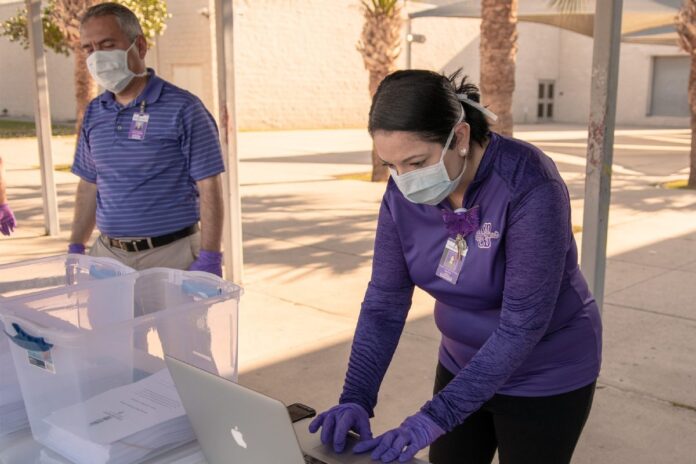The fact that the number of COVID-19 cases in Cameron County has remained lower than initially feared is likely attributable to shelter-in-place, travel restrictions, social distancing and other emergency mandates imposed to stem the flow of the virus, and the fact that most residents have abided by them, according to county Judge Eddie Treviño Jr., speaking at a Wednesday press conference.
Gov. Greg Abbott’s order, announced April 27, allowing restaurants, retail shops and certain other businesses to begin reopening starting May 1 takes away the county’s legal authority to require residents to abide by the mandates, which include wearing masks or facial coverings in public, though the county will continue to strongly recommend that residents keep observing the precautions that have kept the virus from spreading more, Treviño said.
“ We respect the office of the governor and we respect Gov. Abbott’s decision to implement these changes with regards to the reopening of the economy,” he said. “And we’re going to follow the orders and mandates. However, that does not mean that we will not be issuing our own recommendations. So everything that we’ve got in place, we’re going to continue in the form of a recommendation.”
The county judge also said the county’s midnight to 5 a.m. curfew expires on Friday.
Abbott’s order, along with his phased plan to reopen the state’s economy, “Texans Helping Texans,” is available on the county’s website. Starting May 1, restaurants, retail stores, libraries and museums, malls and movie theaters will be allowed to reopen to 25 percent occupancy as part of phase one. Remaining closed for the time being will be bars, gyms, public swimming pools, bowling alleys, video arcades and game rooms, massage businesses, tattoo parlors, piercing studios, cosmetology salons and barber shops.
Treviño said he’s heard from some restaurant owners who plan to reopen on May 1 but also from others who say they don’t intend to, not yet anyway.
“ They feel that they need to make sure that they’re able to reopen in a way that does not risk their employees or their customers or clients,” he said. “I think that is an extremely smart thing to do, and a very, very cautious thing to do. … We don’t want to reopen or jump too quickly from one point to the next.”
The numbers Treviño discussed at Wednesday’s press conference revealed the county had 387 confirmed cases of coronavirus out of 907 people tested through public labs. Of that number, 236 had tested negative, 171 individuals had cleared the virus and recovered, and 16 had died.
Treviño noted that the county went from 37 cases on April 1 to 387 on Wednesday, a roughly tenfold increase though good news in the sense that the county didn’t hit those numbers earlier. He credited the public’s adherence to social distancing, shelter-in-place and other mandates.
“ I want to thank everybody for their hard work getting us to this point,” Treviño said.
Meanwhile, all credible health experts advise that the push by states to reopen their economies must be accompanied by substantially more testing than has been done so far in order to avoid a second wave of infections. Less than 1 percent of Cameron County’s population has been tested through public and private labs. That’s roughly 4,000 residents — nowhere near where we should be but about on par with the rest of Texas and the nation, Treviño said, adding that comes down to a shortage of test kits. He said the county is working with the state on getting additional testing resources, if only on a temporary basis.
“ We don’t have an announcement yet, but we’re working on that and we’re hopeful that we (will) have some additional testing capabilities in the very near future,” Treviño said.
Without data from widespread testing, the county must rely on hospitals’ COVID-19 patient loads for clues on what the virus is doing, he said. So far hospitals have not seen a big surge in patients, and ideally that trend will continue as the number of new cases in the county appears to be leveling off, though not decreasing yet, Treviño said.
He feels that a lack of coordination with and guidance from the state health department and state department of emergency management continues to impede the county’s response, while the lack of federal action on creating a national testing strategy has left the United States lagging behind other nations in terms of testing.
“ Other countries, many of them, are ahead of us on a per-capita basis, and that’s what we should be working on,” Treviño said. “There’s no reason why our country, with the capability that we have from a scientific standpoint, should … be having a shortage of testing, nor of analysis. … We’ve known about this since day one. We’ve known about the lack of testing for two months, and we’re in the same boat. That’s where I think … federal leadership and support and guidance would have been beneficial. We’d be two months ahead as opposed to hearing this morning that hopefully they can have the tests for us in the next two months. We should be there now.”





